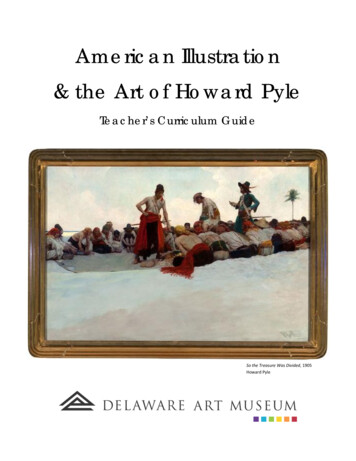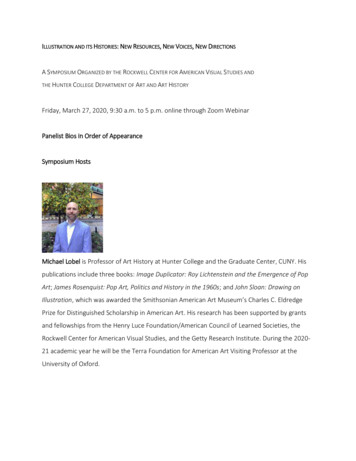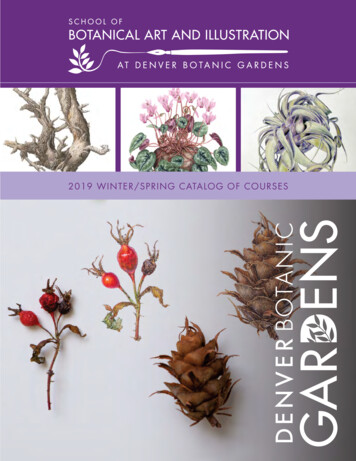
Transcription
American Illustration& the Art of Howard PyleTeacher’s Curriculum GuideSo the Treasure Was Divided, 1905Howard Pyle
TABLE OF CONTENTSHoward Pyle Biography 1American Illustration . . 2Pirates, Princes, & Legends . .3The History of a Nation . .4Curriculum Connections . .5Appendix . .7Harper’s Weekly ArticleMagazine Cover Illustration Activity PageSelections from Leaves of Grass by Walt WhitmanGlossary . .15Works Consulted 16Image Credits .17NOTICE:Several works of art in the Delaware Art Museum’s collection contain partial or full nudity. Whilewe maintain the artistic integrity of these pieces and do not encourage censorship we havemarked these pieces in an effort to provide educators with pertinent information. You will see agreen inverted triangle () next to any works that contain partial or full nudity, or maturecontent. This packet is intended for educators; please preview all materials before distributingto your class.2
HOW TO USE THESE MATERIALSThese materials are designed to provide teachers with an overview of the artists and their workin this exhibition. This information can be used before and/or after a visit to the Delaware ArtMuseum, or as a substitute for teachers and schools that are unable to visit. Teachers shouldadapt these materials according to the grade level and ability of their students.GOALS FOR LEARNINGHistoryTechnologicaladvances in the 20thCenturyAmericanRevolutionary WarLanguageVocabulary relatedto illustrationNarrative in ArtLiterary influenceson art and societyArtSubject, purpose,and composition ofillustration paintingsTechnology used forart-making.Perceive andinterpret visualelements and cluesLOOKING AT ART WITH YOUNG PEOPLEMuseums are among the best places for teaching people how to look carefully and to learn fromlooking. These skills, obviously critical to understanding art, are also important for experiencing theeveryday world. Frequently referred to as "visual literacy", these skills are seldom taught, despite theirusefulness.There are many ways to approach looking at art. All of them are appropriate at different times. Withyoung people, it is important to discover what catches their attention and try to pursue that interest. Atother times, it might be useful to point out things you have noticed. In so doing, you help young peopleexpand on their experiences and their capacities to think, analyze, and understand.Identifying and talking about recognizable subject matter is a frequent beginning point. Inherent orimagined stories are too. Abstract issues can also be observed and discussed; for example, even quiteyoung children can suggest meanings for colors and see the implied energy in a line or brushstroke.Background information and biographies of artists have less relevance to younger children, althoughthey are almost always of interest to older people. Instead, one can accomplish more by helping youngchildren concentrate on and appreciate the images at hand. An excellent use of time in the Museum,therefore, is for adults and children to point out things to each other, and share their thoughts andfeelings about what they might mean. You can, of course, make mental notes of things you might like toask the artist if he or she were there, but emphasize what you can see and think about, instead offretting about what you do not know. The process of discovering information in paintings can be fun andserious, in part because there are few rights and wrongs.From the Museum of Modern Art's A Brief Guide for Looking at Art3
ABOUT HOWARD PYLEFrom delart.orgHoward Pyle (1853 – 1911)American artist, illustrator, author, and teacherHoward Pyle with daughterPhoebe, c. 1892. Howard PyleManuscript Collection.Today, Howard Pyle is not nearly as well-known as his images. However,he was one of America’s most popular illustrators and storytellers at atime when top illustrators were celebrities. At his death, he wasdesignated by the New York Times “the father of American magazineillustration as it is known to-day.” His illustrations appeared in magazineslike Harper’s Monthly, Collier’s Weekly, St. Nicholas, and Scribner’sMagazine, gaining him national and international exposure. And becausemagazines so influenced the nation’s visual culture, Pyle’s images andstories—including American history and tales of pirates and medievaladventurers—reached millions, helping to shape the Americanimagination.Pyle’s influence and images continue to inform popular culture.Norman Rockwell described him as his “hero,” and contemporaryillustrator James Gurney (the Dinotopia series) is an unabashed Pylefan. Many cinematographers and filmmakers revere Pyle’s art,reflected in Hollywood images of medieval heroes and Caribbeanpirates. Early filmmakers were influenced by Pyle’s techniques ofstorytelling, and costume designers and actors (like Errol Flynn)referenced Pyle’s depictions of pirates and Robin Hood. This legacycontinues in later 20th- and early-21st-century film, illustration, andanimation, where artists continue to use his work as both a sourceand an inspiration. Pyle’s experiences as an artist, writer, illustrator, Howard Pyle at his studio easel, takenand celebrity brought him in contact with fascinating figures in by C.P.M. Rumford, 1898. HowardPyle Manuscript Collection.American history. He illustrated fiction by Mark Twain, Robert LouisStevenson, and Oliver Wendell Holmes, as well as poetry by WilliamDean Howells and history by Henry Cabot Lodge and Woodrow Wilson. Many students’ visions ofAmerican history were shaped by Pyle’s vivid illustrations. As part of the mainstream artist community inNew York, he belonged to the Salmagundi Club, the Century Club, and the Players Club, where hesocialized with the nation’s most famous artists, including Winslow Homer, Augustus Saint-Gaudens,and William Merritt Chase, among others.4
AMERICAN ILLUSTRATIONWhat is Illustration? The term refers to many different styles, artists, andinterpretations—but at its simplest core an illustration is any pictureaccompanied by text. American Illustration experienced its height ofpopularity in the period between 1880 and 1930. At the beginning of this eraillustrated periodicals became a widely sought after form of entertainmentfor the public at large and continued until the rise of the motion picturewhich soon drew more popularity (Elzea 7). During this time Americansenjoyed increased literacy due to greater access to public education andincreased leisure time, both of which encouraged the rapid production andpublication of illustrated periodicals. The advance of illustration as awidespread art form depended heavily upon the technological advances ofthe era. Wood engraving changed significantly during this time period, asHopalong Takes Command, 1905Frank Earle Schoonoverinnovators like Pyle began to push the limits of the linear medium withmore expressive line work. The halftone process was also invented in thelatter part of the century which allowed artists to work in a variety of black-and-white tones due toadvances in the photomechanical reproduction process of tones. This eventually gave way to the fourcolor halftone process which enabled artist to reproduce their work in full color (7). Slowly theseadvances became less cost prohibitive and kept the emergence of illustration moving steadily forward.In many ways Howard Pyle is considered the father of Americanillustration. Previously, most artists were trained with a heavyEuropean influence that dictated stiff forms and predictablesubjects. Pyle questioned the rigid guidelines set forth byEuropean academic training and began to push out into newways of depicting stories through illustration. Academicallytrained painters did not explore the multiple affordancesbetween outdoor light and indoor lighting, deal withmovement, or search out expressive feelings in their subjects.Pyle explored by challenging these conventions of academicpainting and made illustration imaginative in a way that it hadnot been in picture making before this time (Pitz 49).While Pyle led the charge, illustration in America flourishedduring this time period and produced many new names:Katharine Richardson Wireman, Elizabeth Shippen Green, N. C.Wyeth, Norman Rockwell, and countless others. Illustrationallowed artists to expand the smallest moments of life in order to be considered, processed, andexamined. Illustration enabled humor, fantasy, imagination, and history—it told stories andremembered times past, and for that reason it is woven deeply into the history of this country.Cover for The Country Gentleman, November10, 1923, 1923Katharine Richardson Wireman5
PIRATES, PRINCES, & LEGENDSHoward Pyle was intensely interested in matters of historicalfantasy—the stuff of legends and myth. He is best known for hiswork of pirates, specifically in reference to the illustrations hecreated for the book Robinson Crusoe. Through Pyle’s work withpirates he depicted hero-villains such as Blackbeard and otherunsavory characters and buccaneers and largely shaped the way weview these characters today in our imaginations and even on thesilver screen (Loechle 59). Pyle took the elements of piracy thatwere the most provocative (pillaging, marooning, mutiny, battles,treasure, etc ) and penned images of characters that embody thoseideals in depiction as well as description. Previously, drawings ofpirates were overly-simplistic or too gentlemanly—he transformedand consistently influences our collective idea of piracy today. Whilethese characters were influenced largely by Pyle’s imagination,The Mermaid, 1910there is an element of truth to his work that remains to be one ofHoward Pylethe key defining features of his illustrations. Even in the midst of ablue sea where we as the viewer are privy to a private moment between a stranded sailor and abeautiful mermaid emerging from the deep there is an emotion present that resonates—it was thisability to portray emotional reality through imaginary moments that set Pyle apart from hiscontemporaries.Not only was Pyle an illustrator, but also a writer. His interest inArthurian legends is enjoyed through the tetralogy he wrote in theearly 1900s retelling the tales of King Arthur and his Knights of theRound Table that Pyle recalled from his youth. However his first workwas a color illustration of “The Lady of Shalott” by Alfred LordTennyson (Lupack 47). As with all his work, Pyle continued to depictflawed heroes in the ancient legends, turning men like Sir Launcelotinto examples of “flawed perfection” (52) thus giving the stories alife and depth which had previously been absent. His dealings withArthurian legend also inspired his students, namely N.C. Wyeth tocontinue exploring these tales as fodder for imaginative illustration.Wyeth would go on to pass the tradition on to his son Andrew, whoalso created some illustrated works of Arthurian legend.Regardless of subject matter, Pyle consistently “looked for what hecalled the ‘supreme moment,’ the phase of action that conveys themost suspense, often a fateful encounter or a moment of decision”(Gurney 38). This moment presented intense emotion without giving away the story to the wanderingeyes of the reader before it was time, thus enhancing enjoyment.The Enchanter Merlin and IllustratedInitial T with Heading, 1902Howard Pyle6
THE HISTORY OF A NATIONHoward Pyle not only concerned himselfwith issues of fantasy and legend, hewas also heavily immersed indocumenting the history of America. Hepainted important scenes like the Battleof Lexington, the Battle of Bunker Hill,Thomas Jefferson writing in private theDeclaration of Independence, and manyother instances from the AmericanRevolution. Pyle “helped the nationvisualize its own history” (CampbellCoyle 73) by providing the public with avisual memory for moments of greatThe Fight on Lexington Common, 1898Howard Pylehistorical and national import.Howard Pyle, along with several other illustrators, wascommissioned in the late nineteenth century to produce twelvepaintings that would be run in Scribner’s Magazine as illustrationsfor Henry Cabot Lodge’s serialized story, “Story of the AmericanRevolution” (Evans 52). The imagery Pyle creates around theAmerican Revolution is infused with his trademark style—intensefeeling and emotion etched onto the faces of every person in theframe. While evidencing a high level of American patriotism, hispieces were founded in concrete evidence. Pyle drew hisillustrations from historical documents regarding the battles andsought to create historical accuracy (Campbell Coyle 75). Thusauthenticity, in feeling and event, becomes a defining feature ofthese works. Through these works Pyle can be seen as anessentially American artist. His work did show some likeness toEuropean artists of the time as he would have been familiar withinternational work, but he makes clear his allegiance is in creatingThomas Jefferson Writing the Declaration ofand taking part in a new national art. In his article, “A SmallIndependence, 1898Howard PyleSchool of Art” printed in Harper’s Weekly in 1897 he questionsthe existence of a developed American artistic style. Pyle writes,“Why have we no national art?” (85) and goes on to suggest the development of an American identitythrough art (see Curriculum Connection “Being American”), an ideal represented often in his work.7
CURRICULUM CONNECTIONSThis information can be taught before and/or after a visit to a museum. Please adaptthe information and activities to the grade level, ability, and learning styles of yourstudents. Teachers may find some of them more suitable than others for meetingspecific classroom goals. These materials may be reproduced for educationalpurposes.ALL LEVELSVisual Thinking Strategies— Sometimes artwork is off-putting, sometimes it looks complicated, andsometimes it looks like a child could have made it. In order to break down students’ pre-conceptions ormisconceptions use the screencast tutorial on VTS (Visual Thinking Strategies) to help you and yourstudents feel confident about discussing new art, or discussing art at all! This is especially helpful for usein non-art classrooms.Visual Analysis—Using works of art from E-Museum, have students discuss the basic elements of art.Examining the artist’s use of line, color, shape, space, light, and texture encourages students to lookbeyond the image itself to the ways in which it was painted.ELEMENTARY LEVELPlaying Illustrator—Pyle and other illustrators often were tasked with creating images that reflected thetime in which they lived. Use the magazine cover template in the appendix and have students draw acover image. Ask them to write an explanation of why that image relates to their current life.Describing the Imaginary—Pyle was a master of creating reality in the form of the imaginary, askstudents to pick their favorite tall tale, legend, or imaginary thing (e.g. mermaid, unicorn, Paul Bunyan,Abominable Snowman, Dragon, etc.) and describe it in great detail—so much detail that it feels real.Optional: Have students accompany their description with a drawing.Noticing Detail—Pyle was a master of minimizing unnecessary detail. Using the downloadable PowerPoint of images or E-Museum, ask students to look at several of Pyle’s works and point out areas that letthem know what is going on. They might point to the eyes of the soldier and say he looks scared, ormention the embrace of the mermaid ( ) and say she looks like she is in love. Talk about how thepieces Pyle chose to include were important and discuss what he might have left out on purpose.Creating a Story—Print out or project one of the images from our collection on E-Museum, or chooseone from the companion Power Point and ask students to tell a story based on the moment they see inthe illustration. What happened before this moment? After?8
SECONDARY LEVELPlaying Illustrator—Ask students to use a class text (suggested: multi-chapter novel) and select aninstance of the “supreme moment.” They will select a line or two of text that will serve as the directionfor their illustration. Ask them to depict the supreme moment they chose and discuss why it fits thedescription to the class or in a writing assignment. Alternative: Assign lines of text from the book togroups of students and have them work together to depict the supreme moment and explain why thelines might have been chosen.Being “American”— (for advanced grades/readers) Howard Pyle engaged in the discussion ofdeveloping an American style of painting (see his article in the appendix). Today, we might not alwaysthink about whether or not something is truly American or the importance of that. Have your studentsread excerpts from Pyle’s article “A Small School of Art” in conjunction with excerpts from WaltWhitman’s Leaves of Grass (see appendix) and ask them to attempt to summarize what theauthors/artists are saying about America or Americans. What are the similarities? Differences? Whywere people concerned about the identity associated with the artwork (writing and visual) producedduring the 19th century? Make sure to show them some of Pyle’s paintings that typify this idea of an“American art” such as Thomas Jefferson Writing the Declaration of Independence or The Fight atLexington Common. Extended learning: Can your students think of any discussions of this naturehappening in our world today? Is it still important to define ourselves as American in our writing, art,etc.?The Anti-Hero—Pyle had a fixation with creating complex heroes, like his pirates that clearly had flaws,but were painted as heroic in many instances. Ask your students to think critically about the make-up ofan anti-hero. As a class make a “dossier” of the characteristics of an anti-hero. Who in your readingmight fit the bill? Are flawed heroes better or worse than perfect heroes? Are there any examples in theworld today (politics, humanitarianism, pop-culture) that have examples of perfect or anti-heroes?Additional: As a good discussion starter ask students to brainstorm a list of popular televisionshows/movies that have anti-heroes as a central character. Examples might include Breaking Bad,Batman, Pirates of the Caribbean, etc.9
APPENDIXPlease find in the following materials items referenced in the Curriculum Guidewhich may aid in classroom learning. Please also consider downloading thecompanion PowerPoint document for images of the artwork referenced in thisguide.Contents: Harper’s Weekly Magazine excerpt of Howard Pyle’s article “A SmallSchool of Art”Harper’s Weekly illustration activity pageSelections from Leaves of Grass by Walt Whitman10
11
12
13
WHITMAN EXCERPTSSome of these selections can be quite difficult for students. It may be a goodidea to summarize as a class before asking them to look for elements ofWhitman’s writing in Pyle’s writing or images.Democratic Vistas“I suggest, therefore, the possibility, should some two or three really original American poets, (perhapsartists or lecturers,) arise, mounting the horizon like planets, stars of the first magnitude, that, fromtheir eminence, fusing contributions, races, far localities, &c., together, they would give morecompaction and more moral identity, (the quality to-day most needed,) to these States, than all itsConstitutions, legislative and judicial ties, and all its hitherto political, warlike, or materialisticexperiences.”Preface to the 1855 edition of Leaves of Grass“The Americans of all nations at any time upon the earth, have probably the fullest poetical nature. TheUnited States themselves are essentially the greatest poem. In the history of the earth hitherto thelargest and most stirring appear tame and orderly to their ampler largeness and stir. Here at last issomething in the doings of man that corresponds with the broadcast doings of the day and night. Here isnot merely a nation but a teeming nation of nations. Here is action untied from strings necessarily blindto particulars and details magnificently moving in vast masses. Here is the hospitality which foreverindicates heroes . Here are the roughs and beards and space and ruggedness and nonchalance that thesoul loves. Here the performance disdaining the trivial unapproached in the tremendous audacity of itscrowds and groupings and the push of its perspective spreads with crampless and flowing breadth andshowers its proflic and splendid extravagance. One sees it must indeed own the riches of the summerand winter, and need never be bankrupt while corn grows from the ground or the orchards drop applesor the bays contain fish or men beget children upon women.”14
GLOSSARYAcademic: A general term for artworks that seem to be based upon rules set up by some person orgroup other than the artist. Artists created academic artworks by following established, traditional rulesemphasized by leaders of European art schools or academies in the 1700s and 1800s.Buccaneer: A specific term for pirates that attacked ships moving valuable goods during the 17th centuryin the Caribbean Sea. The term has become synonymous with pirate.Illustration: A painting or drawing that was originally created to be viewed with corresponding text.Illustrations were typically found in magazines, periodicals, and books in the early twentieth-century.Supreme Moment: Refers to the exact scene in a text that can display intense emotion and a pivotalmoment without giving up the ending when portrayed in a visual medium.15
WORKS CONSULTEDCampbell Coyle, Heather. “Composing American History: Pyle’s Illustrations for Henry Cabot’s Lodge’s‘The Story of the Revolution.’” Howard Pyle: American Master Rediscovered. Ed. HeatherCampbell Coyle. Pennsylvania: U Penn Press, 2011. 73-85. Print.Evans, Shelby, and Annabel Cary, eds. Delaware Art Museum: Selected Treasures. London: ScalaPublishers, 2004. Print.Gurney, James. “Pyle as a Picture Maker.” Campbell Coyle 31-45. Print.Loechle, Anne M. “Gunpowder smoke and Buried Dubloons: Adventure and Lawlessness in HowardPyle’s Piratical World.” Campbell Coyle 59-71.Lupack, Alan, and Barbara Tepa Lupack. “Howard Pyle and the Arthurian Legends.” Campbell Coyle 4755.Pitz, Henry C. "Howard Pyle and the Brandywine School." 200 Years of American Illustration. New York:Random House, 1977. 46-53. Print.16
IMAGE CREDITSCover Page:1. So the Treasure Was Divided, 1905. Howard Pyle (1853-1911). Oil on canvas, 19 1/2 x 29 1/2 in.Delaware Art Museum. Museum Purchase, 1912.Page Five:1. Hopalong Takes Command, 1905. Frank Earle Schoonover (1877–1972). Oil on canvas, 23 ¼ x 291/2 in. Delaware Art Museum, Bequest of Joseph Bancroft, 1942.2. Cover for The Country Gentleman, November 10, 1923, 1923. Katharine Richardson Wireman(1878-1966). Oil on illustration board, 28 22 in. Delaware Art Museum. Gift of Sharon S. Galm,2010.Page Six:1. The Mermaid, 1910. Howard Pyle (1853-1911). Oil on Canvas, 57 7/8 x 40 1/8 in. Delaware ArtMuseum. Gift of the children of Howard Pyle in memory of their mother, Anne Poole Pyle, 1940.2. The Enchanter Merlin and Illustrated Initial T with Heading, 1902. Howard Pyle (1853-1911). Inkon bristol board, composition: 9 1/16 6 3/16 in., sheet: 11 15/16 8 5/8 in. Delaware ArtMuseum. Museum Purchase, 1912.Page Seven:1. The Fight on Lexington Common, April 19, 1775, 1898. Howard Pyle (1853-1911). Oil on Canvas,23 1/4 x 35 1/4 in. Delaware Art Museum. Museum Purchase, 1912.2. Thomas Jefferson Writing the Declaration of Independence, 1898. Howard Pyle (1853-1911). Oilon Canvas, 36 1/4 x 24 in. Delaware Art Museum. Museum Purchase, 1912.17
Norman Rockwell described him as his “hero,” and contemporary illustrator James Gurney (the Dinotopia series) is an unabashed Pyle fan. Many cinematographers and filmmakers revere Pyle’s art, reflected in Hollywood images of medieval heroes and Caribbean pirates.











